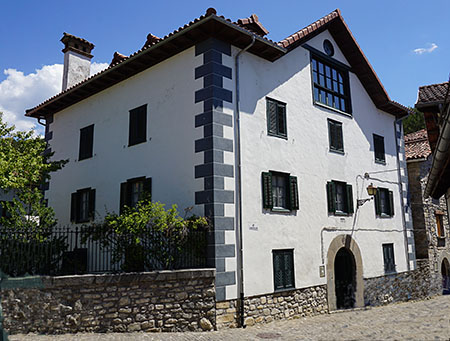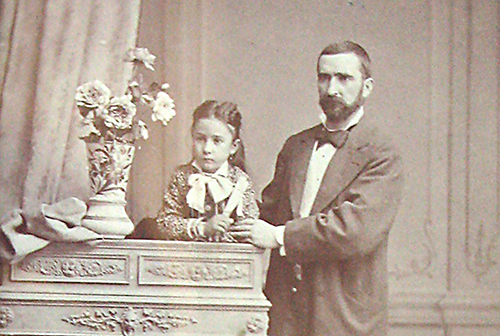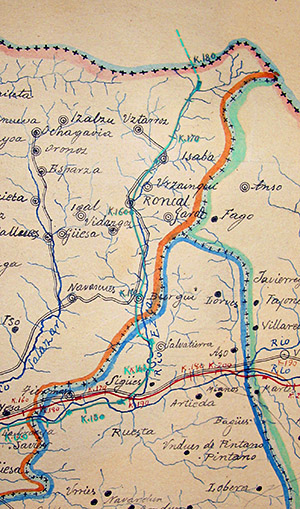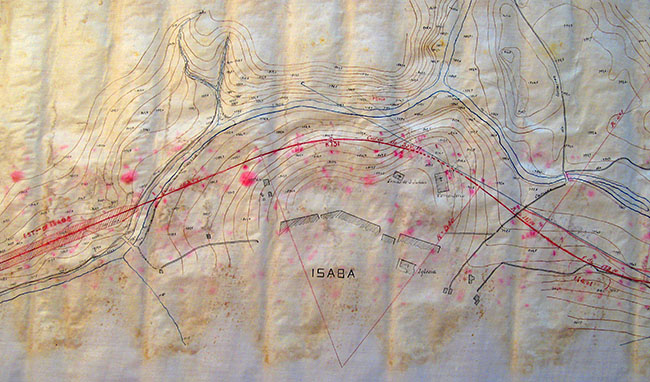The piece of the month of March 2017
MAPS OF THE RAILWAY ROUTE THROUGH THE RONCAL VALLEY. A NINETEENTH-CENTURY PROJECT BY GREGORIO GARJÓN
José Ignacio Riezu Boj
research center in Nutrition
University of Navarra
jiriezu@unav.es
For 40 years Gregorio Garjón Barrena fought with all his strength to build a railroad line through the Roncal Valley. He did not succeed. The core of this work presents a series of maps of the route of this project, kept for years in the house that Gregorio built in his hometown, Roncal.
Gregorio Garjón Barrena
Gregorio was born in Roncal on March 12, 1840 into a well-to-do family, the eldest of three brothers. His father and grandfather were carpenters. At the age of 11 he was orphaned and his mother remarried, although she was widowed very soon. At the age of 15 he was sent to Lumbier to perfect the family official document . On his return to the village, when his grandfather died and he was 21 years old, he was left in charge of the family. With the inheritance received by his mother and other family inheritances he obtained sufficient capital and decided, with his mother, to build a new and important family house in the village. In 1869 he married Eulalia Petra Labari, from a wealthy house in Roncal. As a result of this marriage four children were born, of which only one daughter survived childhood. Gregorio was widowed in 1876, leaving his only daughter, Evarista, 6 years old, at position .

House of Gregorio Garjón in Roncal

Gregorio Garjón and his daughter Evarista ca. 1876
His social concerns soon led him to become a councilman, representative in the board of the valley and mayor of his town, position from which he was deposed when the Carlist troops entered Roncal in 1874. This setback made him flee the valley and join his cousin Julián Gayarre, who was already emerging as an important tenor and whom he would accompany until his death as administrator.
Gregorio was an enterprising man, seeking throughout his life to promote the progress and modernization of his town and valley. To this end, he promoted a multitude of improvements in the town, such as the repair of the streets of the village, reforms of the accesses to the church, repairs in the old cemetery, improvements in the road that goes up to the neighborhood of the Castle, construction of chimneys in the municipal oven or the remodeling of the Town Hall. He was part of the valley commission that negotiated with the Provincial Council the construction of the road from Navascués to Uztárroz. business He was the promoter of the road from Salvatierra to Burgui or Garde, and partner founder, with his brother and cousin, of the stagecoach company "La Roncalesa", the first passenger transport company in the valley. Other projects of his were the exploitation of the derivatives from the distillation of pine resin, for which he formed with his brother the company "Resinera Garjón y Cia", or the construction of five waterfalls in the river Esca for the manufacture of wood pulp for paper.
The project railroad through the Roncal Valley
But the most important business and the one in which Gregorio Garjón put more effort throughout his life was the construction of a railroad line that passed through the Roncal Valley. Gregorio wanted progress to reach his land and for that he knew that it was essential to modernize the communication routes of the valley. Gregorio, as we have seen, was involved in the construction of several roads in his land, but he aspired to more, and in the era of the railroad he wanted to promote a road that communicated Roncal with the rest of the world. He also participated in other railway projects, such as the Pasajes-Jaca line passing through Pamplona or the Castejón-Fitero line, of which there is reliable evidence of his participation in the written press of the time. We are in the second half of the 19th century, in the middle of the railway construction fever. Spain, like the rest of the western countries, although with delay, had granted by means of different laws great advantages to the particular investors to impel the modernization of the country by means of the creation of a radial network of railroads that united Madrid with the rest of Spain. This impulse meant a leap in the creation of Spanish railway infrastructures. Thus, in 20 years (from 1850 to 1870) the country went from having 29 km of railway line to 5,442 km. Gregorio Garjón's project can be inserted in this modernizing boom.
In 1876 the General Administration of works of the Ministry of Development granted authorization to Gregorio Garjón to make "programs of study of a railroad from Zueza following the river Gállego, up to Peña and passing through Bailo, Salvatierra and the valley of Roncal ending in France". Gregorio commissioned the project to José Canalejas Casas, a famous engineer from Barcelona, expert in railway matters and father of José Canalejas, future president of the committee of Ministers of Spain, who was assassinated in 1912. During the years 1878 and 1879, he presented the project to the Diputación de Navarra and the committee General de Pau and both corporations approved it unanimously. In 1880 and 1881 several pamphlets and books were published explaining and vindicating the suitability of the plan. The project was submitted to the Ministry of Public Works on December 20, 1881 and, after sending corrections, the board de Caminos, Canales y Puertos issued a very favorable report . However, the Ministry of Public Works said nothing. It was a project that reached the border and it was perceptive the report of the Ministry of War. This Ministry had already issued several unfavorable reports to project, but on May 19, 1882 it communicated that "the mentioned railroad is detrimental to the defense of the country, not being able to admit another opening in the Pyrenees without it being conveniently defended... and therefore an absolute refusal will proceed from the military point of view..., but that if interests of the country of another order advised the creation of this or another line, they could be reconciled with the indispensable one of not leaving our border uncovered...".
Although it was a major setback, Gregorio continued to fight for the project. On October 20, 1882, he asked the Provincial Council to support the railroad through the Roncal Valley. The Diputación did so by sending several letters to the Ministry of Public Works, to the Count of Heredia Spinosa, Dean of the Navarrese representatives at court, to the corporations of Logroño, Soria and Guadalajara and to several town councils through which the line passed in Navarre to encourage them to support the railway project before the Ministry. In addition to these efforts, which had no practical effect, in 1884, on the occasion of the arrival in Pamplona of the international commission of the railroads through the central Pyrenees, the Provincial Council drafted a new exhibition in favor of the project Roncalés. Before this commission, which visited Roncal on 26th June 1884, Julián Gayarre gave a concert in support of his cousin's project . During these years from 1880 to 1884 there was a fierce struggle in the local press between the defenders of the Roncal route and the defenders of another link in Navarre with France: the Alduides railroad. In spite of the continuous failures, Garjón continued defending his project until his death. In 1889 he was mentioned in a new pamphlet published by the Imprenta Provisional of Soria, programming the railroad from Roncal passing through Ágreda, Castejón and Sangüesa in the direction of the border. The deputy to Cortes Mr. Los Arcos carried out managements to find out if the towns of Navarre would yield lands for the railroad, asking for agreements to be taken in this respect. On February 23, 1914, Gregorio participated in an assembly of towns from Navarre and some from Aragon that was held in Sangüesa, in which they urged the Diputación to do everything possible so that the Madrid-France connection that the Ministry of Public Works had just completed, approve , would pass through Navarre. They were all the towns of the Roncal Valley, as well as Salvatierra Sigüés, Ansó and Hecho among others.
Being mayor of his town, on August 6, 1915 at 3 o'clock in the morning, Gregorio Garjón died in his house in Roncal. The Town Council, that same day, in an extraordinary board agreed "unanimously to record in certificate the deep feeling that has caused the death of its president of whom there will remain a pleasing report in this town in attention to the many improvements that he introduced, both in the time that he served as mayor, and particularly, because he always showed towards his town an extraordinary affection; also agreeing that the Town Council in plenary session of the Executive Council assist to the conduction of the corpse to the cemetery that will take place tomorrow at 9 o'clock in the morning". Blas Aguilar Alvarado, in ABC in 1926 said of him: "Gregorio Garjón was of the smart race of Roncal and carpenter in Lumbier, without more culture than the first letters that he learned in his childhood. His natural talent developed a lot. Eusebio Blasco called him in Le Figaro great Spanish engineer. He was Gayarre's cousin and grew up with his blouse over his shoulder, taking the fresh air. He was active and financial". Bernardo Estornés Lasa, historian born in Isaba, referred to him in his work El valle del Roncal published in 1927: "Roads and railroads were an obsession for him. His projects were the railroads from Pasajes to Jaca, Castejón to Fitero and several others, but the main one was the direct Paris-Madrid railway passing through the Roncal Valley".
The maps
In the house that Gregorio Garjón built in Roncal in 1863, a collection of almost one hundred maps is preserved, among which there are about thirty railway routes. The complete route through the Roncal valley can be found on three large original maps, forming part of other large-scale routes (maps 36, 45 and 46 of the collection).

Map 36. Detail of the railroad route through the Roncal valley.

Map 46. Detail of the railroad route through the Roncal valley.
The cartography of this collection allows us to discover the great variety of layouts that were studied and the different links proposed with other lines already built, in execution or projected. Thus in these maps, in a complicated network of colors, appear traced a multitude of railway lines from Navarre and Aragon that are shown in the legends as built, authorized, projected, studied or discarded. Among the Navarre lines, we can highlight those of Jaca-Sangüesa, Pamplona-Sangüesa, Pamplona-Irún, Pamplona-Logroño, Estella-Vitoria, Estella-Mendigorría, Castejón-Sangüesa, Castejón-Pamplona, Peralta-Mendigorría or Sangüesa-Grisen. The route through Roncal connected with the Jaca-Sangüesa-Pamplona line. There were 30 kilometers between the entrance to the valley by the muga between Burgui and Salvatierra and the border with France, being in the route four stations: Burgui, Roncal, Isaba and the so-called international station of Belagua.
Some of these tracings are more detailed in 4 original maps on cardboard (numbers 39, 41, 47 and 48) and 16 original maps on cloth (maps 43 and 44 and from 49 to 62). The latter stand out for their size. They are between 30 and 38 cms. wide (except maps 43 and 44 which are 64 cms. wide) and are surprising for their exceptional length, ranging from 1.75 meters for the shortest one to more than 15 meters for the longest one. The maps present two types of scale 1:10.000 and 1:2.000 and due to their great length they are rolled up. Some of them have suffered deterioration in the first rolled layers caused by humidity. These maps show the contour lines, rivers and streams, roads, altitude points, relief escarpments, houses, corrals and villages that the railway line, marked by a red line, encounters along its path. This red line, thicker, stands out above the rest of the thin brown, blue or black lines that indicate the level lines, the fluvial courses or the roads and buildings respectively. Bridges, hermitages, dams, as well as signs of the direction of the water current also appear on the maps, all of this seasoned with the names of rivers, ravines, villages, borders, hermitages and some geographical features. And highlighting in red, the marks and numbers of the mileage of the railway line and, from time to time, marking the route, the big train stations. The precision of the maps reaches such detail that the railroad route is subdivided into numbered sections of curves (marked on the map as Ca) and straight lines (Ra) with their lengths in millimeters. In addition, in the curve sections, the radius (Rº) and the Degrees of curvature are indicated in Degrees and seconds. source These maps, in addition to their great beauty, are an important source of information on the orography and geography of the time.

Map 60 rolled up
The map issue 60 of the collection presents part of the Roncal valley in great detail. It is a 38 cms. wide by 8.19 meters long map on canvas. It shows 16 kilometers of the railway line at a scale of 1:2,000, between the Burgui exit (kilometer 118) and entrance of the railroad in the Belagua valley (kilometer 134). The route crosses the towns of Roncal, Urzainqui and Isaba. It is to be supposed that other missing maps would complete the route through the valley. As we have already mentioned, the map is notable for the presence of chapels, bridges, partial plans of the villages with their cemeteries, mills and dams, the layout of the road and paths, as well as the toponymy, toponymy and hydronymy of the area. The imposing stations designed for Roncal and Isaba, more than 300 meters long and reminiscent of the nearby and impressive Canfranc station, also stand out. All these details allow us to study and evoke the great changes suffered in a century in these villages.

Map 60. Railway route through the Roncal valley. Detail of the Roncal station and its passage through the town.

Map 60, railroad route through the Roncal valley, detail of its passage through Urzainqui.

Map 60. Railway route through the Roncal Valley, detail of its passage through Isaba.
With this research I wanted to present this great railway project that was the effort of a lifetime and unfortunately never saw the light. Gregorio Garjón is sample as a man from Roncal who deserves to be remembered not only for having been the administrator of his cousin, the tenor Julian Gayarre, but also for having tried with all his strength to bring progress and modernity to his homeland.
SOURCES AND BIBLIOGRAPHY
file Gregorio Garjón House. Correspondence and maps.
file Municipal of Roncal. Book of Abolengo, Books of Agreements nº 68, 70 and 76, Book of conference proceedings nº 85, Book of Accounts nº 71, Civil Registry, Files of correspondence with the Diputación de Navarra and with the Civil Government of Navarra.
file Parish of Roncal. Book of enrollment and book of births.
file Real y General de Navarra, Notarial Protocols Section, Notary Office of Roncal, Notary Ildefonso Egurbide.
Gaceta de los caminos de hierro, December 15, 1878.
Lau-Buru, October 24, 1882.
The Dynasty, June 20, 1884.
La Correspondencia de España, October 25, 1889.
Diario de Navarra, February 24 and 28, 1914, August 13, 1915 and June 24, 1905.
ABC, January 9, 1926, p. 5.
ESARTE MUNIAIN, P., El ferrocarril europeo de Navarra, Pamplona, Imprenta Popular, 1982.
ESTORNÉS LASA, B., El valle del Roncal, Tip. La Académica, Zaragoza, 1927.
SUSO ESPADAS, I., Alduides versus Roncal, Pamplona, Universidad Pública de Navarra, 2006.
Examination of the benefits that the construction of a direct railroad from Madrid to the French border through Baides, Castejón and Roncal would bring to Spain. Ed Gregorio Juste, 1880.
Apuntes relativos al ferro-carril de Madrid a la frontera francesa por el valle de Roncal, considerado el punto de vista militar, Ed. Gregorio Juste, 1880.
Ventajas de un ferro-carril de Madrid a Francia por el Valle de Roncal bajo el punto de vista comercial, Ed. M. Romero, 1881.
Perjuicios que a la defensa del territorio español pueden producir las comunicaciones a través del Pirineo central y muy especialmente el ferrocarril que se intenta construir desde Madrid a la frontera francesa por el Valle del Roncal, Ed F. Maroto e hijos, 1881.
speech Delivered by Mr. Los Arcos at the session of the congress on May 9, 1888, on the occasion of the discussion of the project bill granting a refundable advance to the Aragonese joint-stock company concessionaire of the Canfranc railroad. Canfranc y Roncal, Ed. Alfredo Alonso, Madrid, 1888.
